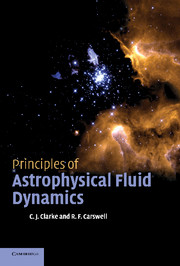Book contents
- Frontmatter
- Contents
- Preface
- 1 Introduction to concepts
- 2 The fluid equations
- 3 Gravitation
- 4 The energy equation
- 5 Hydrostatic equilibrium
- 6 Propagation of sound waves
- 7 Supersonic flows
- 8 Blast waves
- 9 Bernoulli's equation
- 10 Fluid instabilities
- 11 Viscous flows
- 12 Accretion discs in astrophysics
- 13 Plasmas
- Appendix Equations in curvilinear coordinates
- Exercises
- Books for background and further reading
- Index
1 - Introduction to concepts
Published online by Cambridge University Press: 05 June 2012
- Frontmatter
- Contents
- Preface
- 1 Introduction to concepts
- 2 The fluid equations
- 3 Gravitation
- 4 The energy equation
- 5 Hydrostatic equilibrium
- 6 Propagation of sound waves
- 7 Supersonic flows
- 8 Blast waves
- 9 Bernoulli's equation
- 10 Fluid instabilities
- 11 Viscous flows
- 12 Accretion discs in astrophysics
- 13 Plasmas
- Appendix Equations in curvilinear coordinates
- Exercises
- Books for background and further reading
- Index
Summary
Stated most simply, fluids are ‘things that flow’. This definition distinguishes between liquids and gases (both fluids) and solids, where the atoms are held more or less rigidly in some form of lattice. Of course, it is always possible to think of substances whose status is ambiguous in this regard, such as those, normally regarded as solids, which exhibit ‘creep’ over sufficiently long timescales (glass would fall into this category). Such borderline cases do not undermine the fact that the vast majority of substances can be readily classified as fluid or not. If they are fluids, then it is important to understand the general problem of how they flow, and under what circumstances they attain equilibrium (i.e. do not flow). These issues, in an astronomical context, form the subject of this book.
There is also a more subtle point about the sorts of systems that can be described as fluids. Although fluids are always in practice composed of particles at a microscopic level, the equations of hydrodynamics treat the fluid as a continuous medium with well-defined macroscopic properties (e.g. pressure or density) at each point. Such a description therefore presupposes that we are dealing with such large numbers of particles locally that it is meaningful to average their properties rather than following individual particle trajectories.
- Type
- Chapter
- Information
- Principles of Astrophysical Fluid Dynamics , pp. 1 - 11Publisher: Cambridge University PressPrint publication year: 2007

